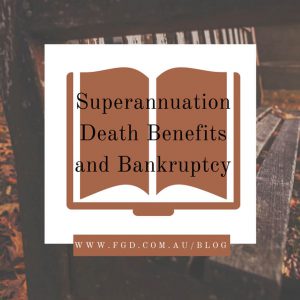
In a recent Federal Court decision of Trustees of the Property of Morris (Bankrupt) v Morris (Bankrupt) the court gave some fresh guidance on the status of superannuation death benefits when received by bankrupts.
The Issue
The respondent in this matter (Ms Morris) was the bankrupt widow of the deceased (who incidentally was also bankrupt at the time of his death). Following his death as if often the case Ms Morris received superannuation death benefit payments from two superannuation schemes which the deceased had been a member of. One of these payments of $311,865 which was a life insurance and anti-detriment payment was not the subject of the proceedings for reasons we will cover below.
However the two funds made additional payments totaling $112,632. The Bankruptcy Trustee sought a determination from the Court as to whether these two payments were property that vested in the bankrupt or if it was exempt property and belonged to Ms Morris.
What does vest mean?
When someone becomes bankrupt all their property vests or becomes the property of the Bankruptcy Trustee and available for distribution among creditors to the bankrupt. There are some exceptions to this rule however which are contained in s.116(2) of the Bankruptcy Act 1966. If an exception applies the property remains the property of the bankrupt. For the purpose of the Morris case the relevant exemptions were:
- The interest of the bankrupt in a regulated superannuation fund
- A payment to the bankrupt from a regulated superannuation fund received on or after the date of bankruptcy that is not a pension
The payment referred to above which was payment of life insurance was exempt under the same section as it was payment of life insurance in respect of the spouse of the bankrupt. The question before the court was whether the other payments were also exempt.
What did the Court say?
The Bankruptcy Trustees essentially argued that Ms Morris did not have an interest in the superannuation fund and therefore the payments were not exempt. In other words, they said that the payments were only exempt if the bankrupt had an interest in the regulated superannuation fund itself whereas the payment does not amount to an interest in the fund and therefore is not exempt.
The Court held however that Ms Morris did have an interest which was created the moment that the Trustee determined to pay the death benefit to her and that interest is an interest in a regulated superannuation fund. Accordingly the payment was exempt and did not vest in the Bankruptcy Trustee.
The Court also pointed out that the payment of superannuation as a result of a splitting order under the Family Law Act 1975 would also be exempt. This is useful to bear in mind as non-superannuation property which is transferred as a result of a property settlement under the Family Law Act 1975 does not have the benefit of the same exemption. With clever drafting a bankrupt may still be able to get a fair settlement by “bargaining” some of their non-exempt non-superannuation property for exempt superannuation property in a settlement with their former spouse.
This case is useful as a reminder that if you or any of your beneficiaries are bankrupt or at risk of being bankrupt that you ought to get advice from the right experts. Careful thought may allow the maximum amount of your estate being available for your family, rather than it being eaten up by creditors.

Paul Salinas is a Family Lawyer and Superannuation expert at Farrar Gesini Dunn, Canberra Office.